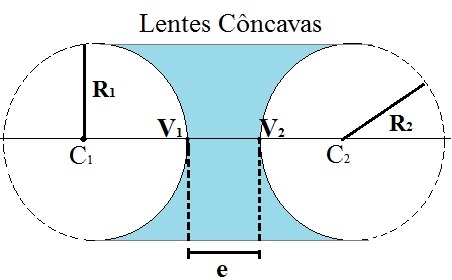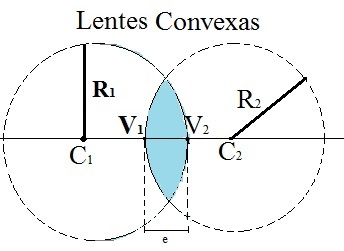At lenses are optical devices that work by light refractionand are widely used in our daily lives, such as glasses, magnifying glasses, in cameras, camcorders and telescopes. The material that makes them up is usually glass, but plastic can also be used. The main features of these devices are transparency and spherical surface.
According to the curvature presented, the spherical lenses can be classified as:
Converging lenses, or positive: when the center part is thicker than the edges. They can be of three types:
biconvex lenses: have two convex parts;
plano-convex lenses: have a flat side and a convex side;
concave-convex lenses: with one side concave and the other convex.
divergent lenses, or negative: if the center is thinner than the edges. They can be classified as:
biconcave lenses: if the two faces are concave;
Flat concave lenses: when they have a flat side and a concave side;
Convex concave lenses: with a convex side and a concave side.
The following figure shows the shape of each of these lens types:

The figure shows the converging and diverging lens types
In addition to shape, lenses can also be classified according to the optical behavior of light rays after hitting them. In this case, they can be divergent or convergent.
In a divergent lens, when light rays fall parallel to the main axis, they suffer double refraction and spread out. . Look at the picture:

Optical behavior of light rays in a divergent lens
As the focus of these lenses is formed by the encounter of projections of incident light rays, it is classified as virtual.
In the converging lenses, the light rays fall parallel to the main axis and, after suffering refraction, they are concentrated in a single point, this point is the focus.

Optical behavior of light rays in a converging lens
The focus of converging lenses is classified as focus real, as it is the result of the meeting of refracted light rays.
Spherical lens elements
What characterizes a spherical lens are its geometric elements, which are:
Ç1 and C2: centers of curvature of the spherical faces;
R1 and R2: radius of curvature of the spherical faces;
Main axis of the lens: where are contained C1 and V1;
and: lens thickness;
V1 and V2: Lens vertices.
See how these elements are arranged in the lenses:

Arrangement of elements in concave lenses

Arrangement of elements on convex lenses
When the thickness of the lens is much smaller than the radius of its faces, it is called thin lens. In this type of lens, the vertices V1 and V2 they are practically at the same point on the main axis and are now called the optical center.
By Mariane Mendes
Graduated in Physics

